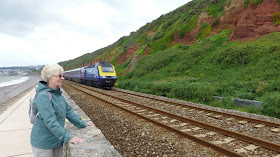Devon is the only English county which shares a border with Cornwall, and the only county which gives its name to a geological epoch.
Barbara and I have just returned from a week in South Devon, the highlight of which was a short but spectacular coast path walk in the South Hams, from the Kingsbridge estuary, near Salcombe, to Sharp Tor, an area of jagged Devonian schist outcrops.
 |
| Kingsbridge estuary near Salcombe |
Unfortunately we based ourselves further north in the relatively unattractive town of Paignton in the centre of the "English Riviera" between Brixham and Torquay.
This stretch of coast, up to Dawlish, is very different from that of Cornwall, or of Devon's South Hams. It is dominated by New Red Sandstone sediments, which give rise to the distinctive red cliffs and beaches of this region.
 |
| Red sandstone beach at Paignton |
The area most familiar with visitors travelling to Cornwall by train will be that near Dawlish, where Brunel's Victorian rail tracks (posting of 10 December 2012) cut dramatically through the red cliffs, formed from aeolian (wind-blown) sand which was laid down in the Permian period around 250 million years ago.
 |
| The Penzance to London Paddington mainline train passing by the sandstone cliffs at Dawlish |





No comments:
Post a Comment
If you have difficulty posting a comment, please email the comment to bwills@min-eng.com and I will submit on your behalf